|
The
|
THE BURGENLAND BUNCH NEWS - No. 230 March 31, 2013, © 2013 by The Burgenland Bunch All rights reserved. Permission to copy excerpts granted if credit is provided. Editor: Thomas Steichen (email: tj.steichen@comcast.net) Our 17th Year. The Burgenland Bunch Newsletter is issued monthly online. It was founded by Gerald Berghold (who retired Summer 2008 and died in August 2008). |
Current Status Of The BB: * Members: 2145 * Surname Entries: 7171 * Query Board Entries: 5106 * Staff Members: 17 |
This newsletter concerns: 1) THE PRESIDENT'S CORNER 2) CHRISTINE REMEMBERS…Part II (by Christine Pöltl Rubba) 3) THE 2012 HUNGARIAN CONSTITUTION 4) HEILIGENKREUZ AND ITS HISTORY (by Hannes Graf) 5) AVAILABILITY OF BURGENLAND RECORDS 6) HISTORICAL BB NEWSLETTER ARTICLES: - DR. LADISLAUS BATTHYÁNY-STRATTMANN BEATIFIED (by Bob Strauch) - FAMILY INFORMATION CONCERNING BATTHYÁNY BEATIFICATION (from Ladislaus E. Batthyány) - MORE INFORMATION CONCERNING BATTHYÁNY BEATIFICATION (from Bob Strauch) 7) ETHNIC EVENTS 8) BURGENLAND EMIGRANT OBITUARIES (courtesy of Bob Strauch) |
1) THE PRESIDENT'S CORNER (by Tom Steichen)  Concerning
this newsletter, after the Bits and Pieces in my President's
Corner below, we get down to full length articles starting with Part II of one by
Canadian BB Member Christine Pöltl Rubba, who was born in Burgenland. I asked
her about her life in Burgenland and she responded with a two-part article, Christine
Remembers... (Part I was last month). Our second article is one about the new
2012 Hungarian Constitution. Hungary was in need of a modern, post-Communist
constitution, but I'm not convinced that the one put in place in 2012 is the right one for the
Hungarian people nor that the process of creating it was appropriate... read the article and
decide for yourself. The last two articles are a report by Hannes Graf on the
History of Heiligenkreuz im Lafnitztal and a gathering together of information on
the Available Burgenland Genealogical Records. Concerning
this newsletter, after the Bits and Pieces in my President's
Corner below, we get down to full length articles starting with Part II of one by
Canadian BB Member Christine Pöltl Rubba, who was born in Burgenland. I asked
her about her life in Burgenland and she responded with a two-part article, Christine
Remembers... (Part I was last month). Our second article is one about the new
2012 Hungarian Constitution. Hungary was in need of a modern, post-Communist
constitution, but I'm not convinced that the one put in place in 2012 is the right one for the
Hungarian people nor that the process of creating it was appropriate... read the article and
decide for yourself. The last two articles are a report by Hannes Graf on the
History of Heiligenkreuz im Lafnitztal and a gathering together of information on
the Available Burgenland Genealogical Records.The remaining articles are our standard sections: Historical Newsletter Articles, and the Ethnic Events and Emigrant Obituaries sections. So I start with some bits and pieces for you: Großpetersdorf Offer: New BB Member, Angyne Smith is returning to her ancestral village this summer and makes an offer...
So, if there is something Angyne might be able to do for you, please contact her via her
email address (found in her Member entry) or write me and ask that I pass along your request.
This same site will also allow you to search and view Probate indexes and documents for
1800 to 1976. Just enter a surname in the "Search Box" near the top of the page. Mathildae Hamedl Rogan wrote: Tom, I would like to purchase a copy of Alois Schmidl's "The Cooking of Burgenland" in English. Can you advise how to do this? Thanks. l replied: Hi Milly, the book is available online at amazon.de.
That is a German language site and transactions are done in Euros (I assume your credit card
company would handle such a transaction, though for an extra fee). This is a 1992 book,
written in English. The BB’s Bob Strauch was the translator so I’ve asked him if he has copies
or additional advice. He may email you directly or, if he goes through me, I’ll forward his
comments on. Ed. Note: As promised, I passed Bob's comment on to Millie. Although I
did not mention the following to her, a significance of this cookbook to the BB is that it
served as a major resource for Burgenland recipes in Gerry Berghold's "A Taste of Burgenland"
series of recipe articles that ran in the BB Newsletter (but, perhaps that is why Millie asked
about it!). |
2) CHRISTINE REMEMBERS… (by Christine Pöltl Rubba) [Ed. Note: This is the second of a two-part article, with the first part published last month. After Christine, who emigrated to Canada from Burgenland in 1968, joined the BB a few months ago, I asked her to write about her personal experiences as an emigrant. The first part of her article spoke of her time in Burgenland and took us to her arrival in Canada. This second part is a response to a series of follow-up questions I asked. Christine will touch just a bit more on the emigration process itself then will cover her time in Canada. Again, My thanks to Christine for sharing!] I had written to Christine: I had hoped you might tell us more about the emigration process itself (but perhaps there is not much more to tell?). I’m not familiar with Canada’s process of accepting immigrants and becoming a citizen (and I assume you did become a citizen), so, if there is more detail, I’d like to hear about it. It must be harder, for example, than moving from North Carolina to Pennsylvania (which is what I did this past year!). Also, I had asked about life in Canada… did you become part of a Burgenland expatriate community? Or a German one? Have you (often) traveled back to Burgenland? How are relations with your family, who you left behind? Do you miss the old country? Was Herbert of a related ethnic background (and when did his family come to Canada)? Was your English/French training adequate to get along in Canada? Or were you able to use German? …I assume you routinely spoke German at home in Burgenland, as Pöltl appears to be an ethnic-German name, though Oberpullendorf has/had a Magyar concentration so I might be wrong! All these kinds of questions, I guess, are targeted around what made your life (as an immigrant) different or difficult (if it did) relative to longer-term Canadians. I may be wrong in assuming you had some transitional difficulties but, if you did, they are worthy of writing about. Her responses follow: 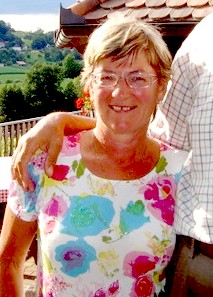 CHRISTINE
REMEMBERS… Part II (by Christine Pöltl Rubba) CHRISTINE
REMEMBERS… Part II (by Christine Pöltl Rubba)The process to emigrate to Canada can be, at times, difficult and, as far as I remember, often the government of Canada asked a spouse in a young couple, who was already living in Canada or already a Canadian, to sponsor the other person. Today there is a point system, where language skills come into play and where the profession of the individual and whether that particular profession is needed in Canada, that helps a person to emigrate. As to my personal situation, since I had a college degree and was able to converse in French and English with the officer at the Canadian Embassy, there was never a question whether my husband had to sponsor me. Therefore I assumed that I emigrated on my own merit. Did you become part of a Burgenland expatriate community? After we arrived in Edmonton by train, we stayed for a couple of weeks with my mother-in-law until we purchased a house on the north side of Edmonton. Herbert started to look for work and found a job with Poole Construction as a carpenter. Unfortunately, the carpenters soon went on strike and Herbert had to make a choice: go on strike with the other carpenters in Edmonton or go to work for Poole Construction out of town, up north in Grand Prairie, which was a 6-hour drive from Edmonton.  He chose to go up north and I found myself alone at home during the week. I had obtained my driver’s license in Oberpullendorf when I was 18 but found out I had to obtain a driver’s license again here in Edmonton. So, I went to take the written exam and passed it. Then I needed to do the driving test and took the VW Bug we had purchased to the testing place. When the inspector found out I had come there by myself, he flunked me immediately and scolded me. So, next day, I asked my father-in-law, John Gurtler, who my mother-in-law had married here in Edmonton in 1964 or so, to come with me for the test drive. He did and I passed the exam. While Herbert was working up north the whole week, I took the time to discover Edmonton, by public transportation, the bus. I  went all over and really discovered a lot of places. Herbert already had made some friends,
since he came over in 1959, and I got along with them as well. However, they were all Germans
who had come over to find their fortune in the fifties and sixties. Eventually we joined
Club Austria, which was very successful and had over 300 members at their best time. I was
trying to connect to the Austrians and became the secretary.
went all over and really discovered a lot of places. Herbert already had made some friends,
since he came over in 1959, and I got along with them as well. However, they were all Germans
who had come over to find their fortune in the fifties and sixties. Eventually we joined
Club Austria, which was very successful and had over 300 members at their best time. I was
trying to connect to the Austrians and became the secretary.But it did not work. The Austrians of that club, especially from Burgenland, the ones to whom I tried to connect, were very cliquey and did not accept us into their circle. Herb was a German, and they were friendly, but they never offered us two chairs at their table. I remained the secretary of Club Austria until 1975, when we decided to go Austria to live there with our two boys. My parents really wanted us to live in Oberpullendorf. They bought a lot across from their house, an older house on the business street. In November 1970, I gave birth to our first son, Victor Paul, by Cesarean and, in 1974, to our second son Klaus, again by Cesarean. My gynecologist did not recommend to us to have another child, and we were happy with both our healthy boys. So, we decided to go to Austria. We sold our house and, by the way, we had sold our house that we had bought in 1968, after Herbert had built a house on an acreage of 14 acres. We sold this second house in 1975 and moved to Austria. I went to Eisenstadt to take a course at the Wirtschaftsinstitute for the license to open up a restaurant, a fast food type. I had to pass an exam and then we set out to finish the building that our parents had started for us. The main floor was supposed to be for the business and the upstairs was to be the apartment for us to live in. While finishing up the apartment, we lived with my parents. That part was not easy since my mother and I are of the same character, and we clashed quite a bit. Especially since my mother wanted to interfere when my husband made decisions with the kids. But after a good talk to my mother, she understood and it went smooth after that. Herbert did most of the work, putting tiles on the floor, carpets in the bedrooms, painting the walls, installing the light fixtures after we purchased them, building in the living room a fireplace using sandstone from St. Margarethen and building the kitchen cupboards. When we were done upstairs, he started with the downstairs restaurant. He put tiles on the floor, made the tables (steel bottoms, which had to be welded (geschweisst) and arborite [Ed note: a countertop material similar to Formica and named after the Canadian company that developed it] on the top of the tables. He built the counters for the bar, where we installed the coolers and the ovens, the kitchen, etc., etc. 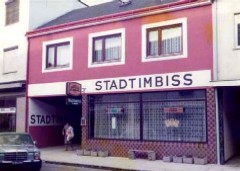 Eventually,
September 13, 1976, came and we opened up our very own Stadtimbiß [City Snack Bar] (80
seats). We had quite a good selection of food. We made French fries fresh from potatoes: we
had a woman peel them for us, put them through the slicer, and fry them. Later we had to buy
the pre-cut ones because we could not keep up with the demand. Sometimes a whole school class
showed up and wanted fries to go, in the paper “Stanitzel” [an inverted paper cone],
with ketchup or mayonnaise. Eventually,
September 13, 1976, came and we opened up our very own Stadtimbiß [City Snack Bar] (80
seats). We had quite a good selection of food. We made French fries fresh from potatoes: we
had a woman peel them for us, put them through the slicer, and fry them. Later we had to buy
the pre-cut ones because we could not keep up with the demand. Sometimes a whole school class
showed up and wanted fries to go, in the paper “Stanitzel” [an inverted paper cone],
with ketchup or mayonnaise.My dad, Viktor Pöltl, loved to help. Every day he came across the street. He was already retired and my brother, Wicki, had taken over the business of knitting (Strickwarenfabrik Pöltl [Knitwear Factory Pöltl]). My dad loved to talk to the customers and he knew most of them. 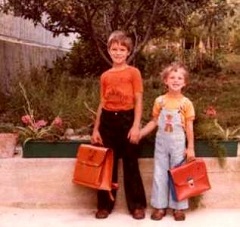 Our
older son, Victor, went to Vorschule [nursery school] and then to grade 1 (1.
Volksschule [elementary school]) in Oberpullendorf, and our younger one went to
Kindergarten. We made Hamburgers with Fries, Bratwurst, Gulaschsuppe, Blutwurst, and even
minute Steaks, and Herbert was very much involved in cooking and getting the merchandise
bought in Vienna, and both of us looked after the children together. Our
older son, Victor, went to Vorschule [nursery school] and then to grade 1 (1.
Volksschule [elementary school]) in Oberpullendorf, and our younger one went to
Kindergarten. We made Hamburgers with Fries, Bratwurst, Gulaschsuppe, Blutwurst, and even
minute Steaks, and Herbert was very much involved in cooking and getting the merchandise
bought in Vienna, and both of us looked after the children together.The only thing we did differently from what was the norm in Burgenland was the business hours. We opened Monday to Friday from 7 am to 7 pm and on Saturday from 7 to 1 pm. Then we closed up and enjoyed our family life. Herbert went back to Canada in July 1977 with Victor and I closed the restaurant for 4 weeks and joined him with Klaus. Already on the first day when I arrived in Edmonton, I knew there was something up. Herbert had to make a choice whether he wanted to return to Canada to live there or whether he wanted to continue with me running the Stadtimbiß in Oberpullendorf. He did not want to tell me right away, but I insisted, and he wanted to return to Canada. He could not see himself living this way with the Imbißstube [snack bar] for the next 25 years. He loved the outdoors, and that was impossible to combine with our business in Oberpullendorf. We returned to Austria, all 4 of us, and set about to find someone to buy the restaurant and lease the building. We found everything we looked for and, after a very difficult goodbye to my family, especially my father, we returned to Edmonton in 1978. Victor, our oldest, had finished grade 1 in Oberpullendorf, and I registered him in New Sarepta, a small town close to Edmonton, to go to Grade 2. Victor had already learned to print and write, and knew his numbers from 1 to 100 and had started the time tables up to four. BUT he knew no English. After a couple of weeks, I noticed that he was regressing with his reading, he started to look at cartoons where he was previously able to read. I checked back at the school and found out that he had the misfortune of an older teacher who was sick quite often and being replaced many times by a substitute teacher. So, I went to the principal and asked him to put Victor into grade 3. I had held him back in Austria, since he was born November 1970, and now I was putting him a grade ahead. The principal was not pleased. He told me he can't stand those German women who were on their high horses. But I remained firm. I did two things after that: I made a deal with our son Victor that we would do 1 hour of English work, writing, reading, etc., from then up to Christmas, which was in about 3 months, and then I would leave him alone. The second thing I did, I baked cinnamon buns every week and brought these to the staff room. I offered to help anywhere they needed me, reading with a student, checking here, or helping there. Victor did well and after Christmas the marks improved and he did not have one C in his report card at year end. The principal eventually conceded that I had made the right decision. Where did we live? Before we left for Austria, we purchased an acreage about 25 km from Edmonton, and there Herbert put up a hut the size of a single garage. Anything we could not sell, we put into that hut. When we came back from Austria, we lived in that little hut for about 2 and a half months. Herbert used that time to build our new house, a split level, on a 3-acre parcel in a subdivision. Herbert was building and I did the purchasing. I bought two-by-fours, nails, wire mesh, anything he needed. Victor was in school from 8 to 4 pm and Klaus stayed with dad or came with me. Sometimes I had to drive to Edmonton twice or even three times and, with our VW Bus, I lugged all home. Sometimes I had to stand at the building supplies store and wait, because nobody asked me what I wanted (I was a woman), so finally I blew up and put my hand down really loud and complained: my money is just as good as the men's and I wanted service. 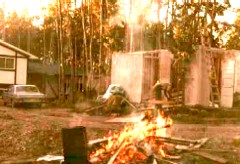 And
I got it after that, promptly! And
I got it after that, promptly!Sometime in October 1978, the house had heat, water and windows, and we moved in. The hut and the Jonny-on-the-Spot were burned in a big bonfire. Herbert still had to get the kitchen cupboards built, and the bathroom counters, etc., but that did not matter; it was warm and we were inside.  Herbert
built, all in all, 9 houses that we lived in and then sold. I was the purchaser and he the
builder. Mind you, he build those houses after work. He was back working at Poole
Construction, which eventually became PLC Construction, a very successful company that is
still building in Canada and USA. Eventually he became foreman and then a superintendent. Herbert
built, all in all, 9 houses that we lived in and then sold. I was the purchaser and he the
builder. Mind you, he build those houses after work. He was back working at Poole
Construction, which eventually became PLC Construction, a very successful company that is
still building in Canada and USA. Eventually he became foreman and then a superintendent.Your question as to when Herbert came to Canada: His mother, Albertine, had to flee from Ostpreussen with her small children, Herbert, Rosemarie, Hildegard and Ulric. They were not allowed to leave their farm in 1945 until the very last minute because the man in charge, Koch, would have them shot if they did. So, they fled and crossed over the Ostsee, with their wagon. Unfortunately, her husband Paul and one daughter, Elisabeth, had been taken prisoner by the Russians, and now Albertine tried to get away with her 4 children. They were almost run over. They made it to the West in 1950 and tried to settle in Hanover, where they stayed for a while. One brother, Willi, put down his roots in Kamp-Lintfort [a town near Essen and Düsseldorf, about 150 miles southwest of Hanover], and that is where they also set up to live. Hildegard and Ulrich dreamed of Canada. So they both emigrated in 1952 and, in 1958, they invited their mother Albertine to come to Canada. Herbert and Rosemarie stayed in Kamp-Lintfort. Hildegard found her mother a husband, John Gurtler, and one year later, in 1959, Herbert and Rosemarie emigrated to Edmonton, Canada, with their mother. 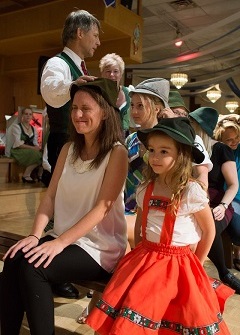 Coming
back to our social life: Club Austria no longer interested us because we could
not get any friends (they did not need new friends, the old ones were good enough). So, in
1988, we became members of the German Canadian Cultural Association, located in
Edmonton. Soon, I was asked to join the executive and became secretary. We were welcomed with
open arms. Everyone was pretty well new to the club since it had been an amalgamation of three
German clubs. After a while I became Director at Large and, for the last 10 years or so, I was
Director for Public Relations. It's only last year, 2012, that I resigned from the board. I
wanted to make room for younger people. Coming
back to our social life: Club Austria no longer interested us because we could
not get any friends (they did not need new friends, the old ones were good enough). So, in
1988, we became members of the German Canadian Cultural Association, located in
Edmonton. Soon, I was asked to join the executive and became secretary. We were welcomed with
open arms. Everyone was pretty well new to the club since it had been an amalgamation of three
German clubs. After a while I became Director at Large and, for the last 10 years or so, I was
Director for Public Relations. It's only last year, 2012, that I resigned from the board. I
wanted to make room for younger people.In 1980, our son Klaus started Grade 1 in New Sarepta and I had to make a decision: did I want to find a job? I wanted to be home for the kids when they came home with the school bus, but what to do all day? I was not interested in staying home all day and watching TV or cleaning house or going shopping all the time. So I took a couple of courses, among others, one where you find out your strengths and weaknesses. I took a sewing course and learned to sew T shirts for my boys and practiced on myself. Herbert said, do what ever. You don't have to work. So I started to take courses at the University of Alberta. One or two courses, passed them, picked other courses and, over the years, I had quite a selection. I even took French, which I had not used for 14 years. Eventually I had to make a decision: what did I really want to get out of the University? My mother always wanted me to become a teacher. When I was 15, that was the last thing I wanted to become.  So
I went to the department of Education at the UoA, presented all the courses I had taken from
1980 to 1985, and asked which courses they would give me credit for if I wanted to do my
Bachelor of Education, major French and minor English? All the courses except one (Psychology
101) were given credits. Now I had to go to UoA full time, since I had to start my teaching
apprenticeship. That was a bit tough, but our boys were doing well in school and now it was
time for me. I finished in 1987 and received my degree in 1988. So
I went to the department of Education at the UoA, presented all the courses I had taken from
1980 to 1985, and asked which courses they would give me credit for if I wanted to do my
Bachelor of Education, major French and minor English? All the courses except one (Psychology
101) were given credits. Now I had to go to UoA full time, since I had to start my teaching
apprenticeship. That was a bit tough, but our boys were doing well in school and now it was
time for me. I finished in 1987 and received my degree in 1988.As to the question whether I did a lot of teaching? No, not really. I was taking care of my parents in Austria, whenever my brother Wicki went on holidays with his wife Heidi, and stayed in Austria with them. There is no teaching job that gives you that much holiday time. So I became a substitute teacher for a couple of years. When I was around, I worked. I taught in French Immersion schools, where you are talking French all the time, in the elementary classes, or in French as a Second Language classes, where you talked both English and French. I also taught German in the public school system as a substitute teacher. Being a teacher was fun. We had a German Saturday School where we took our children every Saturday so they would not forget their German. Have you (often) traveled back to Burgenland? After we returned for good to live in Canada in 1978, we did not return to Burgenland until 1981. Herbert quit his job at Poole Construction and we stayed in Oberpullendorf from August until Christmas. In January, we returned to Edmonton. This way we could enroll our children in school in Austria, and they refreshed their German language skills and made new friends. We returned to Canada, and kept repeatedly returning to Austria every three years. Herbert and I enjoyed reconnecting with my family, and the kids did the same with their friends. 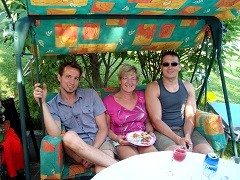 When
our son Klaus got married to his wife Maki in 1999, his three best friends came from
Oberpullendorf to be at his wedding in Edmonton. When
our son Klaus got married to his wife Maki in 1999, his three best friends came from
Oberpullendorf to be at his wedding in Edmonton.Since we had the apartment in Oberpullendorf, we did not need to stay with my parents or with my brother, Wicki, and that was really an ideal situation. We never felt to be in the way, just enjoyed their company. My parents made a trip to Edmonton, Canada only once, the summer of 1971 and, due to the lousy service they had at a Reisebuero [travel agency], they traveled from Vienna to New York to Toronto to Edmonton. Both never spoke an English word but they arrived after an almost two-day trip at our airport. I suppose they wanted to see whatever Herbert or I had told them about Edmonton and, when they realized everything was true, they were happy and satisfied and never wanted to come back to Edmonton. No wonder after such a trip! We showed them the Rocky Mountains, Banff, Calgary and they enjoyed their grandson, Victor. In 1986, I had a funny feeling that something was going on at home. I tried to call but there was no answer. I talked to my husband and said that it was weird that no one answered the telephone. So I called back again and my mother answered. I asked her whether everything was alright and she asked me back, why I was asking that? It turned out that my dad, Viktor, had cancerous polyps and they needed to be taken out. Within 24 hours, I was in Austria and sat at my dad's bedside. The operation took three hours, where they removed some intestines, especially those with the cancer. My mother and brother and I, we waited anxiously and, the longer it took, the more confidence I had that dad would be alright. I kept telling that to mom. My dad never knew he had cancer. He survived this cancer by living another 10 years. My mother, Anna, became ill in September 1989 and, in February, my brother called me by telephone to tell me, she is dying. They finally found out that she had cancer of the liver but there was nothing they could do to help her. He promised to call me when it came to the end but I would still be able to talk with her and, in the middle of May 1990, he called me. I was in Oberpullendorf again within 24 hours and stayed at my mother's bedside. She did not know she was dying. My brother wanted her to die at home, so we took turns looking after her. The doctor came every day to give her a morphine shot, which had to be picked up by my sister-in-law, Heidi, at the Bezirkshauptmannschaft in Oberpullendorf, the reason being, that she was staying at home. I stayed up all night with her, only dozing off at the kitchen table or on the Sitzbank (bench at the table), and my brother looked after her with dad during the day. When mom wanted something, someone was always close by. When she realized that she was dying, she was very sad, mad and disappointed. She passed away on May 31, 1996, at home in her own bed. I helped dress her for the funeral with my aunt. It was an eerie experience. She had been in so much pain, was moaning all the time, that I believed that the pain killers were not very helpful. To this day I still believe that. My dad survived my mother by 6 years. Every year we came to Oberpullendorf to look after him when my brother went on vacation. To this day we still go to Austria every year, sometimes in the Spring or Fall, sometimes in the Summer. We speak German at home all the time. With our boys, we Skype in German, write in German, and when the daughter-in-laws are around, we speak English.  About
25 years ago, my husband joined a men's club, Schlaraffia. The goal of Schlaraffia
is to support the three pillars: Art, Humor and Friendship, and this is done in the
German language. The club originates in Prague, about 154 years ago, and was a satire on the
society. The men are all knights, run through a period of development, and eventually become a
Ritter (knight) (see www.schlaraffia.org).
There are many friends we have met through Schlaraffia and we have a fantastic time
when we go to Austria or Germany or France, etc. About
25 years ago, my husband joined a men's club, Schlaraffia. The goal of Schlaraffia
is to support the three pillars: Art, Humor and Friendship, and this is done in the
German language. The club originates in Prague, about 154 years ago, and was a satire on the
society. The men are all knights, run through a period of development, and eventually become a
Ritter (knight) (see www.schlaraffia.org).
There are many friends we have met through Schlaraffia and we have a fantastic time
when we go to Austria or Germany or France, etc. So, when we go to Austria, I notice that our old friends from way back are still there, most of them, but we have grown apart. But our new friends through Schlaraffia make our stay a wonderful time. Only a couple of years ago, we started to travel to Mexico. My husband used to travel to Mexico before my time, and now we do it together. It is our 8th time in Puerto Escondido. First time we stayed for 3 days and then for 1 week. We traveled about in Mexico, using the excellent bus system, but now we are happy to stay put. As to the German Canadian Cultural Association: I resigned from the executive but I still look after the website, www.gcca.ca, and the library, which I run with a team of volunteers. You can check it out online. One other thing: I took over the German Saturday School as a Schulleiterin [headmistress/principal] in the 80s, where Klaus went to learn German. We had about 34 students. The teachers were mothers who wanted their children to learn German. The location was a Lutheran church. When I took over, I started to replace the mothers with teachers in training, young people who went to the UoA to become teachers and who were speaking German. Then I applied to Alberta Education to have the Grade 10, 20 and 30 German courses also taught at our school.  Condition
was, an Alberta Education Certificate. I increased enrollment to 124 students; it was a
booming school. Politics got in the way and I resigned from the school. Eventually this school
amalgamated with another German school, Edelweiss, and is now called the German
Language School of Edmonton. I m happy to report it is still going, though not in the
church location but in a school. Condition
was, an Alberta Education Certificate. I increased enrollment to 124 students; it was a
booming school. Politics got in the way and I resigned from the school. Eventually this school
amalgamated with another German school, Edelweiss, and is now called the German
Language School of Edmonton. I m happy to report it is still going, though not in the
church location but in a school.Oh yes, Club Austria: how did it continue? The club started the Vienna Opera Ball in Edmonton and it was a highlight of the Edmonton high society. The proceeds were used to support students studying in Austria, be it Salzburg or Vienna. Ah, and then trouble started. The club split in two and the higher society people left and founded the Johann Strauss Society. They also started their own Johann Strauss Ball. And then almost another split, which was averted by the then president. The members got older and older and started to die and the membership of Club Austria dwindled. About 8 years ago, the executive and membership decided to use up all the money they had accumulated over the last 40 years or so and held events, which they paid for with the club's money. They whittled it down to $3,000. That was two years ago. 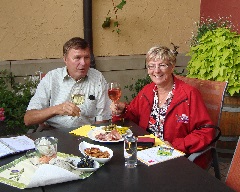 At
the Annual General Meeting of Club Austria in 2011 (Herbert and I had rejoined the Club
in 2009), the president and past president called for a vote to shut down Club Austria.
They wanted to make it a vote by ballot. We had a small group we knew who were willing to
continue as president and directors. Only 31 people were there. I insisted that it should be a
vote by standing up. I told them if you want to kill the Club you should have the courage to
stand up and be known for it. Everyone agreed. 17 to 14 decided that the club would continue.
So, now I am on the executive of Club Austria and so is my husband. We have 4 events
per year and are trying to keep up our club; I do not know whether we will succeed. I only
know when we get together, everyone has a good time. At
the Annual General Meeting of Club Austria in 2011 (Herbert and I had rejoined the Club
in 2009), the president and past president called for a vote to shut down Club Austria.
They wanted to make it a vote by ballot. We had a small group we knew who were willing to
continue as president and directors. Only 31 people were there. I insisted that it should be a
vote by standing up. I told them if you want to kill the Club you should have the courage to
stand up and be known for it. Everyone agreed. 17 to 14 decided that the club would continue.
So, now I am on the executive of Club Austria and so is my husband. We have 4 events
per year and are trying to keep up our club; I do not know whether we will succeed. I only
know when we get together, everyone has a good time. |
3) THE 2012 HUNGARIAN CONSTITUTION Ed. Note: The following article is based on published articles and documents about a highly complex subject: the evaluation and interpretation of a new 2012 Hungarian Constitution. While I've tried to find mostly neutral sources for the basis of this article, I suspect the "anti" crowd (against the new Constitution) is more likely to write than the "pro" crowd, so my selection of sources may be biased in that direction. Nonetheless, my major sources tend to be scholarly assessments (such as Amicus Briefs to the Venice Commission, a body of independent experts providing advice on constitution-making and human rights under the Council of Europe) that are based on what the Constitution says (or refrains from saying), and they seem to be consistent with my reading of the (translated) Constitution. It should be noted that the "official" government translation of the Constitution has been accused of choosing "soft" translations of certain troubling passages... that is, the least "disconcerting" translation among potential translations apparently often appears in the official translation. The official translation is missing certain sub-sections also (however, scholarly, non-official translations are available on the web). If any of you readers have followed developments around this subject and wish to comment, I'd be pleased to publish your views in a subsequent newsletter. On January 1, 2012, a new Hungarian Constitution came into force, replacing the communist-driven Constitution that was enacted in 1949 and then substantially modified in 1989 as Hungary moved from a communist dictatorship to a liberal democracy. By waiting until 2012, Hungary was among the last of the Soviet-satellite countries to fully replace their Soviet-era constitution. So this new Constitution sounds like a good thing, right? Well, the process of creating it, the reactions to the early drafts, and the subsequent challenges to it may suggest otherwise. 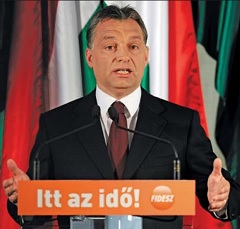 Let
us back up a few years and speak of its origins. In the spring of 2010, in what all agree was
a free and fair election, the center-right political party, Fidesz, a party espousing
conservative Christian social doctrine and led by now Prime Minister Viktor Orbán, received an
unprecedented 53% of the vote due to widespread public disgust with the Socialist party that
had previously been in power. This 53% of the vote translated into 68% of the seats in the
parliament under Hungary’s disproportionate election law. With this supermajority (more than
two-thirds of the parliamentary seats), Fidesz won the power to change the constitution
without the cooperation of any other party... and they have used this power in what appears to
be an extreme manner at every opportunity, amending the old Constitution ten times in their
first year in office and then quickly enacting a whole new Constitution in their second year.
Interestingly, adopting a new constitution was not part of the Fidesz political
platform when it ran for election. Let
us back up a few years and speak of its origins. In the spring of 2010, in what all agree was
a free and fair election, the center-right political party, Fidesz, a party espousing
conservative Christian social doctrine and led by now Prime Minister Viktor Orbán, received an
unprecedented 53% of the vote due to widespread public disgust with the Socialist party that
had previously been in power. This 53% of the vote translated into 68% of the seats in the
parliament under Hungary’s disproportionate election law. With this supermajority (more than
two-thirds of the parliamentary seats), Fidesz won the power to change the constitution
without the cooperation of any other party... and they have used this power in what appears to
be an extreme manner at every opportunity, amending the old Constitution ten times in their
first year in office and then quickly enacting a whole new Constitution in their second year.
Interestingly, adopting a new constitution was not part of the Fidesz political
platform when it ran for election.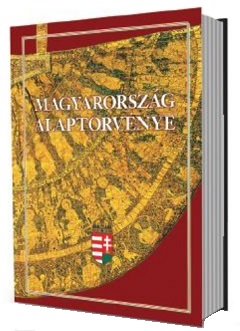 The
new Constitution is embodied in a 2011 document known as the Fundamental Law of Hungary
[Magyarország Alaptörvénye] (sometimes translated as the Basic Law). The
Fundamental Law required and is supplemented by a Transitional Act (defining temporary
provisions needed in moving from the old constitution to the new) and a series of Cardinal
Acts that provide the necessary legal details to implement the provisions of the
Fundamental Law and that, in the future, will also require a supermajority to change, thus in
theory giving stability to the constitution. However, one Amicus Brief stated: "As a
general trend, the old Constitution used the Cardinal Law / supermajority requirement to
ensure heightened protection for fundamental rights, but in the new Fundamental Law, the
function of Cardinal Laws is to place rules about the structure of and personnel in
governmental institutions beyond the reach of a (future) simple majority of Parliament." The
new Constitution is embodied in a 2011 document known as the Fundamental Law of Hungary
[Magyarország Alaptörvénye] (sometimes translated as the Basic Law). The
Fundamental Law required and is supplemented by a Transitional Act (defining temporary
provisions needed in moving from the old constitution to the new) and a series of Cardinal
Acts that provide the necessary legal details to implement the provisions of the
Fundamental Law and that, in the future, will also require a supermajority to change, thus in
theory giving stability to the constitution. However, one Amicus Brief stated: "As a
general trend, the old Constitution used the Cardinal Law / supermajority requirement to
ensure heightened protection for fundamental rights, but in the new Fundamental Law, the
function of Cardinal Laws is to place rules about the structure of and personnel in
governmental institutions beyond the reach of a (future) simple majority of Parliament."From the start, this has been an exercise in authoritarian power, with Fidesz effectively ignoring other political parties, largely ignoring the general public, and quickly forcing through new measures based on party-line votes on superficially-reviewed legislation. Using this approach, the Fidesz government enacted some 359 new laws in their first 18 months of power. And, because many of these laws will require a supermajority to change, the Fidesz policies likely will remain embedded in Hungarian life, even if another party were eventually to gain majority control. While the new Constitution follows the basic form of a liberal European constitution, defining and separating the three branches of power and enshrining human rights, questions arise about its substance and spirit. For example, the Venice Commission expressed serious concerns about the quality of its human rights provisions. The commission found issues with almost all the rights and freedoms recognized under the Fundamental Law, and especially those left out: such as the omissions of an explicit commitment to prohibiting the death penalty and forced labor. Of some interest is the Preamble to the 2012 Constitution, which is denoted therein as the "National Avowal of Faith." In particular, there are phrases which seem incompatible with typical post-modern constitutions. I will provide some quotes:
What makes these sections of some concern is Article Q(3) of the Fundamental Law. It says:
That is, the Preamble must be used in interpreting the Fundamental Law. Such a
requirement is highly inconsistent with most constitutions, wherein the Preamble normally has
no legal, binding authority. One must wonder what those Hungarian citizens of a non-Christian
faith may think; or those whose culture or language is not Hungarian; or even those countries
whose territory was once part of a greater Hungary or who have citizens of Hungarian heritage.
And what does it mean that the "family" provides the fundamental framework for community?
Clearly the Constitution envisions a wider influence, well beyond just legal citizens
within the current borders of Hungary.
Regardless of what one thinks about an appropriate legal status for marriage, I'm not
convinced that its definition should be forced on a nation without due public consideration
and discussion. Here, the political preference of the conservative-Christian Fidesz
party is dictated to the nation and constitutionally entrenched.
Is this a forced labor clause? I'll note that part of Article XI reiterates this position:
Moving into the section entitled Freedoms and Responsibilities, we come across Article II:
Like the marriage definition, I'm not convinced that the definition of when life starts
should be forced on a nation without due public consideration and discussion. Instead, the
political preference of the conservative-Christian Fidesz party is once again dictated
to the nation and constitutionally entrenched.
Compared to the previous Constitution, Article XV (5) protects fewer groups, most notably
omitting minorities. This raised important concerns for the EU. Fidesz then proceeded to establish its own procedures for drafting a constitution, procedures that effectively removed the negotiating positions of all opposition parties and the necessity of political, professional, scientific and social debates. Although the Venice Commission expressed concern about the exclusion of the public and also the opposition political forces and professional, scientific and other nongovernmental organizations, Fidesz charged ahead. The one remaining avenue for public input, a referendum vote to decide on the adoption or rejection of the text, which would have required a majority vote of Parliament to initiate, was summarily rejected by the ruling party. Next comes the question of the Separation of Powers: The big difficulty
concerning the new Constitution's approach to separation of powers involves the guarantee (or,
more accurately, the lack of a guarantee) of judicial autonomy. The 1989 Constitution gave
perhaps excessive power to the Constitutional Court. This power was given primarily in
reaction to the then disproportionate control of the communist-based central government. When
the 1949 Constitution was amended in 1989, the drafters wish to assure a strong counterbalance
to central governmental powers, and that counterbalance was created in the form of a powerful
Constitutional Court (and also in powers granted to Ombudsmen, to be discussed later in a
Fundamental Rights section) that would restrict illegitimate employment of executive or
legislative powers. Two of these topics are the Transitional Act and the recently promulgated
Cardinal Acts.
This definition of family ignores hundreds of thousands of legally-existing Hungarian
families, as recognized under prior law. It also creates a direct link between family and
marriage that does not follow either from the relevant provision of the Fundamental Law or the
international laws Hungary has ratified. Registered same-sex partners, childless de facto
partners and cohabiting or registered partners (regardless of gender) raising children who are
biologically related to only one of them while "living in an emotional-economic community"
(the phraseology previously used to define a legal family relationship) may not be covered by
this definition, thus these individuals may lose all benefits and protections accorded to
families. One example benefit/protection is intestate succession (i.e., who inherits if a
partner dies without a will). Under prior law, a registered partner was second in line (as was
a spouse) behind direct descendants, and was entitled to inherit, in the absence of direct
descendants, without further ado. Under the new law, they hold no special right to inherit and
would need to take legal action to claim against distant kin or even the government.
My suspicion is that such support is diminishing day by day. |
4) HEILIGENKREUZ AND ITS HISTORY (by Hannes Graf) We have been republishing some articles Hannes wrote over the past two years for placement on his personal site, Spirit of Gradišće - Őrvidék Group. This month, we are presenting an article about Heiligenkreuz im Lafnitztal (Hungarian: Rába-Keresztúr, Romanes: Kerestula) in central Jennersdorf, near the Hungarian border. 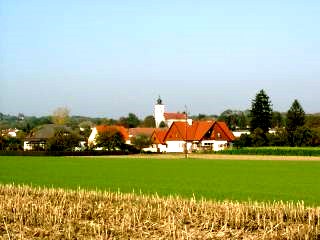 As
the agricultural hub of the West Hungarian lowlands, Heiligenkreuz in the Lafnitz Valley has a
long history to look back on. The town was not far from the so-called “Bernsteinstraße”
[Amber Road], which was already an important point of North-South connection during Roman
times and led from the Baltic to the Adriatic Sea. The settlement, which lay on Römerstraße
[Roman Road], was mentioned as early as 1157. The first documented mention of the
settlement, referred to then as “Keresthur” (Kreuzherr), appears in 1428 in King Sigismund’s
letter of bestowal. In the letter, Heiligenkreuz, in relations to the customs office, is
portrayed as an important ancient locality. As
the agricultural hub of the West Hungarian lowlands, Heiligenkreuz in the Lafnitz Valley has a
long history to look back on. The town was not far from the so-called “Bernsteinstraße”
[Amber Road], which was already an important point of North-South connection during Roman
times and led from the Baltic to the Adriatic Sea. The settlement, which lay on Römerstraße
[Roman Road], was mentioned as early as 1157. The first documented mention of the
settlement, referred to then as “Keresthur” (Kreuzherr), appears in 1428 in King Sigismund’s
letter of bestowal. In the letter, Heiligenkreuz, in relations to the customs office, is
portrayed as an important ancient locality.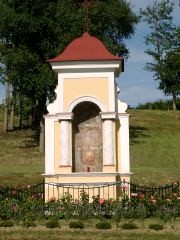 According
to folklore, hundreds of years ago Bavarians and Swabians came to the area, which was
predominantly covered with thick forests. The settlers are rumored to have placed a cross made
of oak on the site where the church now stands. The community’s name, “Keresztur” (Lord
Cross), is said to come from this cross. According
to folklore, hundreds of years ago Bavarians and Swabians came to the area, which was
predominantly covered with thick forests. The settlers are rumored to have placed a cross made
of oak on the site where the church now stands. The community’s name, “Keresztur” (Lord
Cross), is said to come from this cross.
 In
1782, the name of the town was changed to Rabakeresztur and finally to Heiligenkreuz. In the
year 1921, the designation “in Lafnitz Valley” was added. In
1782, the name of the town was changed to Rabakeresztur and finally to Heiligenkreuz. In the
year 1921, the designation “in Lafnitz Valley” was added.On the outskirts of St. Gotthárd, the post office in Heiligenkreuz was very important for the region. The post office was built as early as the middle of the 18th century and is, thus, the oldest post office in South Burgenland. Even early on, Heiligenkreuz was not spared from blows of fate. In 1824 and 1917, large fires raged and destroyed large parts of the community. 400 years earlier, the plague raged, claiming many inhabitants’ lives (an old legend tells of the affliction).  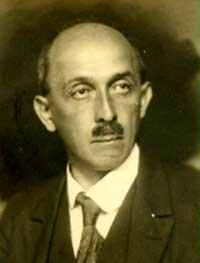 After
the end of the first World War, almost the entire population supported an annexation of
German-speaking West Hungary to Austria. One of the most avid supporters of this idea was the
mill owner, Karl Wollinger, from Heiligenkreuz. He traveled throughout the Lafnitz Valley and
won support of the inhabitants for the annexation. On August 29, 1921, Burgenland was supposed
to be handed over to Austria. The Austrian national police and customs officers marched into
Heiligenkreuz. The next night, they were attacked by Hungarian guerilla fighters and escorted
to St. Gotthárd. From then on, the area was occupied by the guerilla fighters for three
months. The annexation ultimately took place November 28, 1921. After
the end of the first World War, almost the entire population supported an annexation of
German-speaking West Hungary to Austria. One of the most avid supporters of this idea was the
mill owner, Karl Wollinger, from Heiligenkreuz. He traveled throughout the Lafnitz Valley and
won support of the inhabitants for the annexation. On August 29, 1921, Burgenland was supposed
to be handed over to Austria. The Austrian national police and customs officers marched into
Heiligenkreuz. The next night, they were attacked by Hungarian guerilla fighters and escorted
to St. Gotthárd. From then on, the area was occupied by the guerilla fighters for three
months. The annexation ultimately took place November 28, 1921.Destruction of Heiligenkreuz in WW-II 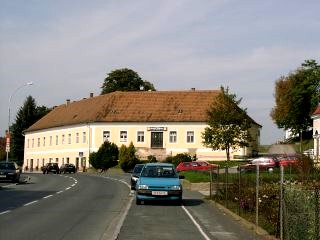 Especially
severe destruction was brought on by WW-II. At the end of March 1945, Russian troops stood at
the town’s door. Ownership of the village changed six times during the combat operations. The
battle lasted 10 days. 75% of the town was destroyed, making it the most severely devastated
in Burgenland. After the war ended, the afflicted population began right away on the
reconstruction of the community, and soon the worst damage was repaired. In 1969, the last
damaged house in Heiligenkreuz was repaired. In its place, the new administrative building
with a kindergarten was built. Especially
severe destruction was brought on by WW-II. At the end of March 1945, Russian troops stood at
the town’s door. Ownership of the village changed six times during the combat operations. The
battle lasted 10 days. 75% of the town was destroyed, making it the most severely devastated
in Burgenland. After the war ended, the afflicted population began right away on the
reconstruction of the community, and soon the worst damage was repaired. In 1969, the last
damaged house in Heiligenkreuz was repaired. In its place, the new administrative building
with a kindergarten was built.In the name of community centralization in Burgenland, in January 1971 Poppendorf and Heiligenkreuz were united with the Heiligenkreuz community. Owing to a decree from the Burgenland federal state government in 1971, the community was conferred the right to refer to itself as a “Market Town.” Since then, Heiligenkreuz has been an important “Gateway to the East” in Europe. Population development 1869-2010 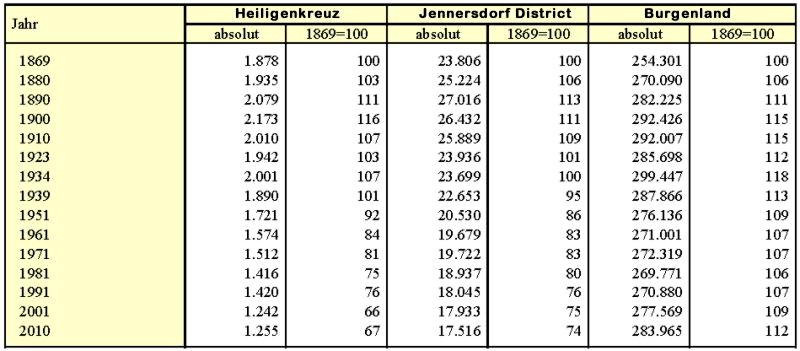 (Credits: Photographs courtesy of Silvia & Günter Nikles) |
5) AVAILABILITY OF BURGENLAND RECORDS Although it has been discussed piecemeal in various BB Newsletters, I thought it worthwhile to gather together the information about Burgenland's genealogical records. As you may know, Roman Catholic parishes were first required, by order of the Council of Trent, to keep baptism records in 1563. It would not be until 1614, that marriage and burial records would also be required. Prior to this, no universal system existed to record vital records (births, marriages and deaths), especially as it pertained to common folk. Even the (sparse) surviving records of the nobility only reach back to the early 1400s and they seldom recorded any vital information about the common folk. After the Catholic decree in 1563, other denominations quickly followed in the 1500s with their own formal and mandated recording systems. Thus, the church registers, the recording of births/christenings, marriages, and deaths/burials (later also first communions, confirmations and conversions), are generally the earliest available records in Europe. The oldest such church registers in Hungary date from the 1630s, but the actual earliest entries in the registers of most parishes were made in the 1686-1740 time period. This occurred because much of Hungary was under Ottoman/Turkish rule from 1526 until 1686, and the remaining parts of West Hungary were under constant threat or attack. Almost certainly, some of the initial records in Burgenland were destroyed when villages were wiped out during the last Turkish siege of Vienna. In addition, the Kurruzen Wars (Hungarian revolution of 1602) destroyed many records in southern Burgenland. It should be noted that Hungary successfully forced the ruling Habsburgs, at the Peace of Linz in 1645, to recognize four religions: Catholicism, Lutheranism, Calvinism, and Unitarianism. Each of these denominations determined separately when recording would start. However, since Unitarianism is identified only with the Hungarian minority in Transylvania, it had no known parishes in the Burgenland area. Of those denominations of interest to Burgenland, here are the details: • Roman Catholic: Most Roman Catholic records begin shortly after the Turks were forced to leave in 1686. • Greek Catholic: In the 1600s, Orthodox ethnic groups agreed to accept the jurisdiction of the pope while retaining Orthodox liturgy and ritual, this compromise accepted in order to gain legal status and its accompanying freedoms and benefits. The resulting Uniate churches were called Greek Catholic. Most Greek Catholic parishes began keeping registers in the mid 1700s. • Reformed: Calvinist Protestantism became the dominant religion of Hungarians in the late 1500s. The keeping of Reformed (Calvinist) church registers began in the early 1700s after the Turks were replaced by the Christian Austrian government. • Lutheran: Lutheranism was accepted by many Germans in Hungary at about the same time Calvinism was adopted by the Hungarians. Their church registers begin in the early 1700s with the departure of the Turks. Lutheran records, for the most part, are located in the churches. During the Nazi era, some were photocopied (the records show stamps to that effect) and may be in Lutheran Archives. • Jewish: Not recognised as a religion until 1781, Jews were required to keep records of births, marriages, and deaths in German, under Catholic supervision, beginning in 1788. However, because these records were also required for conscription and taxation purposes, Jews often evaded registration. Most Jewish communities did not actually start keeping records until the practice was again codified into law in 1840. In 1885, the Hungarian Royal Ministry of Cults required Jewish vital births, marriages, and deaths to be recorded in vital registers that included several congregations in a sub-district rather than in registers for each individual congregation. Exceptions were allowed when individual congregations paid to have their own registrar. • Roma (Gypsy): Technically not a religion, Roma did not internally keep records of births, marriages, and deaths and avoided reporting such to external authorities. They were frequently banned, deported or forced to assimulate by various Hungarian governments. Empress Maria Theresa banned Roma marriages in the mid-1700s and ordered Romani children to be taken away from their parents. Emperor Joseph II prohibited use of the Romani language in 1783. Due to these measures, the Roma were largely assimulated into the larger society by the 19th and 20th centuries, so no separate record systems, then or now, exist. Thus these dates reflect the earliest point where you can expect to find church records... and it would be unreasonable to assume you can go back further. In 1730, Hungarian Catholic priests were ordered to record non-Catholic vital events in their church register books and a new format for the records was introduced in 1771. In 1781, the Emperor Joseph II issued the Toleration Patent, which recognized Protestantism and Judaism throughout the Empire. In 1784, still under Joseph II, regulations for keeping records were implemented. The key regulations are outlined below. • Catholic priests were to function as civil registrars for non-Catholics: Catholic priests kept the official vital records for other religious groups, such as Jews, Lutherans and Orthodox. These other faiths sometimes kept their own records, but the records were not state documents. (However, over time, each of these religious groups was granted official record keeper status by the Austrian government.) • Records were to be kept in Latin: Thus, one must be careful regarding names and languages found in the records. First names were usually translated into Latin and surname spellings sometimes adapted to be "more natural" in Latin. • Records were to be kept in columnar format: It means that all the information is written in columns, making it comparatively easy to read and search the records. It also means that foreign language is less of a problem, requiring only a few key words to be learned. (Compare this to the paragraph format which requires the researcher to pick out the main information from long complicated sentences and to stumble through a larger vocabulary and complex grammar.) • Each type of vital record was to be kept in separate registers: The Catholic priest was to keep three separate registers for each event in the parish: births/baptisms, marriages, and deaths. Furthermore, each village in the parish was to be identified in the records. Thus, it is important that a researcher know the parish his/her ancestor came from. If the researcher knows only the village name, he/she will have to identify the parish the village belonged. The BB, of course, provide this information for villages in Burgenland on its website. For other villages, consult a good gazetteer from the time of interest. Having parish records, as opposed to village records, is generally a good thing for a researcher. If an ancestor moved from village to village, so long as the new village was in the same parish, the vital records would still be bound together. Of course, ancestors could have moved to a neighboring parish. Thus it is a good idea to become familiar with the geography of the region and learn all of the parishes in the immediate area. • Copies of the records were to be made and forwarded to the Bishop: A copy of the birth/baptismal and marriage records was to be made by the priest so that one copy could be transferred to the Bishop’s Consistory. This operation was extended to death registers in 1836. This Austrian mandate was done for tax and military conscription purposes. (These copies, commonly called the Bishop’s copy or the duplicate copy, are one reason records from the area have survived, since two copies would need be destroyed to completely lose the records.) Despite these 1784 regulations, Protestants in Hungary were authorized by 1787 to keep their registers independent of Catholic control. The LDS (Mormon Church) microfilmed most of today's Burgenland church records (all faiths) that were available in archives in Budapest (mostly 1828-1895). Consult the LDS website, https://www.familysearch.org, or the BB LDS webpage, http://www.the-burgenland-bunch.org/LDS/LDS.htm, to find the film numbers. As noted below, the beginning of Civil Registrations in 1895 ended the period where Church records, though still kept, were also official state records. Other records: Church records and nobility archives are not the only sources of records. • Wills. Started in Hungary around 1700. They include the name and age of testator, names of heirs (heirs in most cases are family members or close relatives), date and place of will, and description of the estate. Some of these earliest documents survive but, generally, wills were not written by the common folk. Available wills are in the Hungarian State Archives. • Tax books. Were also begun about 1700. They include the name and residence of the property owner, a description of real property, and the amount of tax paid. For 1700 to 1900, these records are in the Hungarian State Archives; since 1900, city and county archives hold the tax records. • Land registration records (Urbariums / tax
appraisals). Covers 1715-1945 and includes the name of the property owner or head of family
and sometimes names of family members. For 1715 to end of 1800, these records are in the
Hungarian State Archives; since 1800, in local county archives and courthouses. |
6) HISTORICAL BB NEWSLETTER ARTICLES Editor: This is part of our series designed to recycle interesting articles from the BB Newsletters of 10 years ago. This month, I reprint one from NL 116C (March 2003) about Dr. Ladislaus Batthyány-Strattmann (1870-1931), who was beatified in 2003 by the Catholic Church for his medical work with the poor. Dr. Batthyány-Strattmann is unique in that he is the only Burgenländer to receive this high honor from the Catholic Church. For your information, 'beatification' is step three in the Catholic canonization process, wherein one is given the title of "Blessed." Receiving the title "Servant of God" is the first of the four steps in the process and is given to a deceased person of the Catholic Church whose life and works are being investigated in consideration for official recognition by the Pope and the Catholic Church. The second step is being declared "Venerable," upon a decree of heroism or martyrdom by the honored. This is followed by beatification, which requires confirmation of miracles resulting from the intercession of the honored. The final step is canonization, wherein the honored receives the title of "Saint." It turns out that there were two additional articles related to this topic in BB NL 117 (April 2003); I include those also. THE BURGENLAND BUNCH NEWS No. 116C March 31, 2003 DR. LADISLAUS BATTHYÁNY-STRATTMANN BEATIFIED (from Bob Strauch) (ED. Note: The Batthyány family held the Güssing Herrschaft from 1524 to 1918). Bob writes: This week I got my copy of the latest Karpatendeutsche newspaper from Vienna, which also had an article about Ladislaus Batthyány's beatification. He was also well known to the people in and around Pressburg/Bratislava, just a stone's throw from his castle and hospital in Kittsee. My article says that he is buried in the crypt of the Batthyány family castle in Körmend, not Güssing. But according to the Diocese of Eisenstadt website, he is indeed buried in the Franciscan Cloister Church in Güssing. Other tidbits from this article: 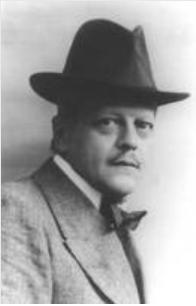 •
A hand bone was recently removed from his remains and will be placed in a shrine as a relic. •
A hand bone was recently removed from his remains and will be placed in a shrine as a relic.• Burgenland parishes organized bus and plane trips to Rome for the celebration. • Deceased Bishop of Eisenstadt, Stefan Laszlo, who visited the Burgenländers in America several times, originated the campaign for Batthyány's beatification. • Batthyány was among the first to perform cataract operations. • He would give children a Gulden (florin, guilder) to "help ease the pain." When this became known, children would feign toothaches just to get the coin. • He was affable, down-to-earth, even folksy, and this endeared him to the "common folk." • The mother of the article's author (family was from Pressburg) was sent to Batthyány as a child because of an earache and hearing loss. He told her, "Don't worry about it, Mitzerl, because there are a lot of things you're better off not hearing anyway!" His all-natural remedy: brew some chamomile tea and let the steam enter the ear through a hole cut in the tip of a Stanitzl (cone). • His castle in Kittsee is now an ethnographic museum (Ethnographisches Museum Schloss Kittsee). I've been through Kittsee several times on my way to Pressburg, but never had a chance to see the museum. A well-known Advent Concert and Market, lasting three days, is held every year at the castle, entitled "Burgenländischer Advent in Schloss Kittsee." The concerts are broadcast on Austrian TV and radio. See www.schloss-kittsee.at. • A memorial to him will be dedicated on March 30th in the Franciscan Cloister Church in Güssing. • For more info, see the Diocese of Eisenstadt website (includes an extensive bio and tribute in English): www.kath-kirche-eisenstadt.at/Batthyány/ [Ed: link is no longer functional; see instead: http://www.batthyany.org/der_selige_ladislaus.html?&L=1] • Click "Batthyány-Gedenkstätte vor Fertigstellung" for an image and description (in German) of the memorial, as designed by architect Johann Traupmann and artist Heinz Ebner, both of Güssing. • Ladislaus Batthyány has now been entered into the online Dictionary of Saints in Germany: www.heiligenlexikon.de/BiographienL/Ladislaus_Batthyany-Strattmann.html • His birthplace, Dunakiliti (Kiliti = St. Cletus, feast day April 26), lies in Györ-Moson-Sopron County and also has a German name: Frauendorf. The Batthyány castle, where he also ran a clinic, still stands and has been turned into a school named after him. THE BURGENLAND BUNCH NEWS No. 117 April 30, 2003 FAMILY INFORMATION CONCERNING BATTHYÁNY BEATIFICATION (from Ladislaus E. Batthyány) With interest I noted that you too mentioned (BB News No. 116C) the beatification of our great grand father, Prince Batthyány-Strattmann in Rome. Just for clarification, I want to point out that this was a unique beatification for one main reason: Batthyány-Strattmann is/was of course buried in our family crypt in Güssing. However, he is also considered a "Hungarian Saint", so the beatification was done by TWO dioceses, Eisenstadt and also Szombathely (Steinamanger). After all, Kittsee was Hungarian when he lived and Körmend (where my father, one of the 27 grand children of the blessed, still lived till WW2) is in Hungary. So also for the whole organization of the beatification it was a big challenge which worked out well, that two countries, two bishops, were involved. For the beatification, the Batthyány Family came as well, all together over 150 members. My father presented the relics to the Holy Father at the ceremony. From Hungary as well, the Hungarian State President attended and from Austria the governor of Burgenland. Also Archduke Otto von Hapsburg and his family attended. The ceremony was also broadcast on TV in Hungary and Austria. The ceremony on Sunday the 30th in the Franciscan Church in Güssing, where the remains of my great grand father were carried into a new shrine by members of the family, at a holy mass with Bishop Iby of Eisenstadt, was very moving! I also want to mention that Güssing (the castle, and family burial place under the church (the largest in Austria, after the Hapsburgs) is still managed by the family Batthyány. This is done via a foundation between the family and the government of Burgenland. Kindest Regards, Ladislaus E. Batthyány, Vienna, Austria PS: Further information can also be found under: www.katolikus.hu [Ed: direct link is: http://batthyany.katolikus.hu/index.html] MORE INFORMATION CONCERNING BATTHYÁNY BEATIFICATION (from Bob Strauch) 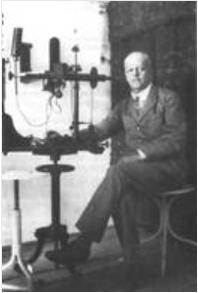 The
beatification of Ladislaus Batthyány has been a very important event in Burgenland, especially
for Güssing, it appears. Busses of pilgrims are arriving from Hungary. The
beatification of Ladislaus Batthyány has been a very important event in Burgenland, especially
for Güssing, it appears. Busses of pilgrims are arriving from Hungary.I received mail from Güssing late last week: a commemorative envelope of the beatification; inside was a prayer pamphlet with Ladislaus Batthyány's biography, a prayer, and quotations, along with a postcard of Batthyány with the following message: "Einen herzlichen Segensgruss von unserem seligen Augenarzt Dr. Ladislaus Batthyány sendet Dir und dem lieben Hianzn-Chor Euer dankbarer Pater Leopold Prizelitz." ("A heartfelt greeting from our blessed eye doctor to you and the dear Hianzn-Chor sent by your thankful, Father Leopold Prizelitz.") |
| 7) ETHNIC EVENTS LEHIGH VALLEY, PA (courtesy of Bob Strauch) Wednesday, April 10: German Music Show at the Evergreen Heimatbund in Fleetwood. Info: www.evergreenclub.org Saturday, April 13: GTV Edelweiss Schuhplattlers' 64th Stiftungsfest at the Reading Liederkranz. Info: www.readingliederkranz.com Saturday, April 20: Spring Concert at the Reading Liederkranz with the Reading Liederkranz Chorus and guest choruses. Dance music by the Joe Weber Orchestra. Info: www.readingliederkranz.com LANCASTER, PA Tuesday, April 2, 5:30 to 7:30 pm: First Tuesday Buffet (Members $10 - Guests $14). Lancaster Liederkranz. Entertainment by Carl Heidlauf. Saturday, April 13, 7:30 to 11:30 pm: Ein Abend In Wien (Semi-formal, Members $8 - Guests $10). Lancaster Liederkranz. Music by Walt Groller. Dinner service available 5:30 to 8 pm. Sunday, April 27, 5 to 6 pm: Spring Concert by the Liederkranz Chorus. Open to the public ~ Free admission. Zion Evangelical Lutheran Church, 85 E Brandt Blvd, Landisville. Sunday, April 27, 6 to 11:30 pm: Buffet Dinner & Spring Dance (Dance, 7:30 to 11:30 pm: Members $8 - Guests $10). Lancaster Liederkranz. Music by Die Immergrün Musikanten. Buffet dinner (6 to 7:30 pm: $12 Adult - $6 Child) follows concert above. NEW BRITAIN, CT Friday, April 5, 7 pm: Heimat Abend. Austrian Donau Club, 545 Arch Street, New Britain, CT (860 223-9401). Music by Joe Rogers. Friday, March 19, 7 pm: Heurigan Abend. Austrian Donau Club. Music by Schachtelgebirger Musikanten. |
8) BURGENLAND EMIGRANT OBITUARIES (courtesy of Bob Strauch) Mary Waldvogel  Mary
Waldvogel, 94, of South Bend, Indiana, passed away at 7:25 pm Monday, February 25, 2013, in
Morningside Nursing Center. Mary
Waldvogel, 94, of South Bend, Indiana, passed away at 7:25 pm Monday, February 25, 2013, in
Morningside Nursing Center.Mary was born on February 3, 1919, in Nikitsch, Burgenland, Austria, to Fabian and Mary (Tompos) Darabos. She was a member of Our Lady of Hungary Church, and member of the former St. Anthony's Society Ladies Auxiliary and DFV Ladies Auxiliary. On June 28, 1941, in South Bend, she married Robert F. Waldvogel, who died on January 7, 2006. She was also preceded in death by a son, Robert, and brothers, Steve, Louis and John Darabos. Surviving are a daughter, Mary Louise Kuminecz of Las Vegas, NV; and 3 grandchildren, Christopher Kuminecz, Anne (Bowd) Beal and Beth (Ben) Kimberlin; and 2 great-grandchildren, Cage Beal and Hudson Beal; and a brother-in-law, Ronald (Judy) Waldvogel. A Mass of Christian Burial will be celebrated at 10:00 am Saturday, March 2, 2013, in Our Lady of Hungary Church. Burial will follow at Highland Cemetery. Family and friends may call from 4-8 Friday in the Zahoran Funeral Home, 1826 Kemble Avenue, where a Rosary will be recited at 4:30 pm. Memorial contributions may be made to Our Lady of Hungary Church. To leave an online condolence, visit our website www.zahoran.com, or our Facebook page, Zahoran Funeral Home. Published in South Bend Tribune on February 28, 2013 Theresa Zotter  Theresa
Zotter, 95, of Toronto, Canada, died peacefully on Thursday, March 7, 2013. Theresa
Zotter, 95, of Toronto, Canada, died peacefully on Thursday, March 7, 2013.Born in St. Martin an der Raab, Austria, she was a daughter of the late Alois and Anna (Schreiner) Winkler. She was predeceased by her husband Frank. She is survived by her family and friends in Austria and Canada. Special thank you to the staff at Leisureworld-Etobicoke, especially Raquel and Elvira, for their loving and compassionate care. Viewing at Newediuk Funeral Home, Kipling Chapel, 2058 Kipling Ave. (north of Rexdale Blvd.), from Monday 10 a.m. until service time in the chapel at 11 a.m. Cremation to follow. In lieu of flowers, donations to UNICEF would be appreciated. Online condolences at www.newediukfuneralhome.com Published in the Toronto Star on March 9, 2013 Gisela Hirmann  Gisela
Hirmann (née Hanzl), 78, of Clifton, New Jersey, passed away on March 24, 2013. Gisela
Hirmann (née Hanzl), 78, of Clifton, New Jersey, passed away on March 24, 2013.She was the beloved wife of Michael Hirmann, devoted mother to Rosemarie Tintle of Riverdale and Kenneth M. Hirmann of Clifton, loving grandmother to Erika and Amanda, and great-grandmother to Adaya. Mrs. Hirmann was born in Gamischdorf, Burgenland, Austria and came to the U.S. in 1955, settling in Clifton. She was a bookkeeper for 15 years with Mahaffy & Harder Engineering Co. in Fairfield. She was an active parishioner of Holy Trinity Roman Catholic Church in Passaic, where she was a member of the church choir and Golden Agers and current president of the Kolping Society. She was also an honorary member and New Jersey representative of the Burgenländische Gemeinschaft. Funeral from the Marrocco Memorial Chapel, 470 Colfax Avenue, Clifton on Wednesday at 9:15 AM followed by a funeral mass at Holy Trinity RC Church at 10 AM. Entombment Calvary Cemetery. Visitation Tuesday 2-4 and 7-9 PM. In lieu of flowers memorial contributions should be made to Holy Trinity RC Church, Passaic. www.marroccos.com Published in The Record/Herald News from March 25 to March 26, 2013. Angela Kessler  Angela
Kessler (née Zach), 75, of Montauk, Long Island, New York, passed away peacefully on February
9th, 2013. Angela
Kessler (née Zach), 75, of Montauk, Long Island, New York, passed away peacefully on February
9th, 2013.She was born in her beloved town of Gerersdorf bei Güssing, Austria on July 22, 1937 - where she traveled back as often as she could to visit and spend time with family and friends. Angela came to the United States in 1949, and she married John Kessler on November 10, 1957. Angela and John have 2 children, Richard and Lorraine, and 7 grandchildren whom she so enjoyed spending time with whether she was baking, gardening, fishing or swimming with them. Angela was an avid volunteer at her original parish in the Bronx, Holy Family. Not only was she a Lector and Eucharistic Minister, but she was a coach for the girls youth softball teams and the girls junior basketball teams which she coached to a CYO Archdiocese title in 1970. She worked as a teacher's aide for the special education class for 8 years at Holy Family and St. Raymond's elementary schools. Angela graduated cum laude with a BS in Education from CUNY Lehman in 1975 and taught for 10 years at Our Lady Queen of Angels elementary school in East Harlem, New York. She implemented and directed many after school programs, which she secured government grants for. Angela's never ending community support eventually got her appointed to Community Board #9 in the Bronx in 1978 where she began volunteering as an administrative assistant for 3 years; was then appointed Chairperson of Land & Zoning Committee for 2 years; appointed Chairperson of the Youth Service Planning Committee for 2 years; appointed Assistant District Manager of Community Board #9 in 1985 and was interim District Manager during vacancies until she retired in 1993. Her adventurous spirit and enjoyment of beaches helped her discover her second home in Montauk, Long Island, whereby she attained her captain's license for the charter fishing trips she and John would run once they retired. In between fishing trips and days at the beach, Angela tended to her vast outdoor garden and indoor flowers and plants; she and John sang on the choir at their parish church, St. Theresa's and enjoyed the many friends they had in the Montauk area in addition to all those who ventured to "the end" to visit with them. The family wishes to express their sincere appreciation and gratitude for all the acts of kindness shown to them in their time of sorrow. Visitation at the Flynn Memorial Home Inc., 1652 Central Park Ave., Tuesday 7-9 pm and Wednesday from 2-4 & 7-9 pm. Mass of Christian Burial will be celebrated 10 am Thursday, at Our Lady of Fatima Church, 5 Strathmore Road, Scarsdale, New York 10583. Interment will follow at Gate of Heaven Cemetery, Hawthorne, New York. Memorial donations may be made to: The Long Island Chapter of Alzheimer's Association, www.alz.org/longisland Agnes Schneider  Agnes
Schneider, age 93, of Murfreesboro, Tennessee, passed away Tuesday, March 26, 2013 at Life
Care Center of Hickory Woods. Agnes
Schneider, age 93, of Murfreesboro, Tennessee, passed away Tuesday, March 26, 2013 at Life
Care Center of Hickory Woods.Mrs. Schneider was born in Punitz, Austria to the late Christoph and Theresia (Radits) Maikisch. She was a member of St. Rose of Lima Catholic Church and an active member of Stones River Seniors Club. Mrs. Schneider was preceded in death by her parents; husband, Edgar F. Schneider; brother, Josef and sister, Theresia. She is survived by her son, Peter James Schneider (Mary) of Murfreesboro; grandchildren, Sarah Anne Busman of Durham, NC, Katie Marie Schneider of Murfreesboro; brothers, Gustav and Johann of Austria; and sister, Anna of Austria. Celebration of life service to be held at a later date. Those wishing may send condolences online at www.murfreesborofuneralhome.com. Murfreesboro Funeral Home, 145 Innsbrooke Blvd., Murfreesboro, TN (615) 896-2229. Published in The Daily News Journal on March 28, 2013 Theresa Strom  Theresa
Mary Strom, 93, of Iselin, New Jersey, passed away Friday March 29th in Perth Amboy. Theresa
Mary Strom, 93, of Iselin, New Jersey, passed away Friday March 29th in Perth Amboy.She was the wife of the late Gustav Strom. Born in Kirchfidisch, Austria, she was the daughter of the late Stefan and Julianna (Gollatz) Schaffer. Retiring in 1985, she was employed by Crum and Foster for many years. She was a member of the Immanuel Union AARP and Widows Club in Staten Island and also volunteered at the Eger Nursing Home. Theresa loved playing cards, sewing, playing bingo and Scrabble. She is survived by her devoted daughter Corinne Fahy and her husband Francis of Port Reading, cherished grandchildren Gregory and Kenneth, both of Port Reading. She was predeceased by her son Richard in 2002 and three brothers. Funeral services will be Tuesday 11:00am from the Chubenko Funeral Home 625 Port Reading Ave., Port Reading followed by interment at Ocean View Cemetery, Staten Island. Visitation Monday 2pm to 4pm and 7pm to 9pm at the funeral home. To send online condolences please visit, www.chubenkofh.com. Published in Home News Tribune on March 30, 2013 |
END OF NEWSLETTER |
NOTICE (Terms and Conditions): The Burgenland Bunch (BB) was formed and exists to assist Burgenland descendants in their research into their heritage and, toward that end, reserves the right to use any communication you have with us (email, letter, phone conversation, etc.) as part of our information exchange and educational research efforts. • If you do not want your communication to be used for this purpose, indicate that it is "confidential" and we will abide by that request. • Correspondents who communicate with the BB without requesting confidentiality retain their copyright but give a non-exclusive license to the BB allowing us to forward to BB members, publish in our monthly newsletter or on our website, and/or subsequently and permanently archive all or parts of such communications. The Burgenland Bunch homepage (website) can be found at: http://www.the-burgenland-bunch.org/ Burgenland Bunch Newsletter, copyright © 2013 by The Burgenland Bunch All rights reserved. Permission to copy excerpts granted if credit is provided. |
 News
News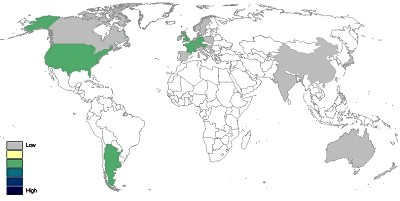 When
you provide the required information, you will get a map like the one to the right (though
much larger than my example image, which is for my surname, Steichen). The map is
color-coded by relative frequency of the appearance of the surname in different countries. As
you can see, the US, Western Europe and Argentina are marked as having intermediate
frequencies of the Steichen surname and Canada, more of Western Europe, and some Far
East countries are marked as low frequency.
When
you provide the required information, you will get a map like the one to the right (though
much larger than my example image, which is for my surname, Steichen). The map is
color-coded by relative frequency of the appearance of the surname in different countries. As
you can see, the US, Western Europe and Argentina are marked as having intermediate
frequencies of the Steichen surname and Canada, more of Western Europe, and some Far
East countries are marked as low frequency.  Wallern
Data and a Request: I recently received a message from Konrad Unger of Wallern. If you
don't know, Konrad is author of a website about Wallern at
Wallern
Data and a Request: I recently received a message from Konrad Unger of Wallern. If you
don't know, Konrad is author of a website about Wallern at
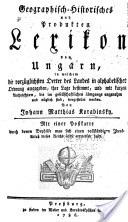
 My
reading of this text is: "Agendorf, ein deutsches Stadtdorf im Oedenb(urg) Kom(itat). 3/4
W(esten) v(on) Oedenb(urg). W(esten) hat schöne Kastanienwälder. [Symbols representing:
Katholische Kirche; Evangelische; Weinbau]." Note that I've expanded the abbreviations and
place them in () and have interpreted the symbols for you. My translation is: "Agendorf, a
German town-village in Ödenburg County. 3/4 west of Ödenburg. To the west, has beautiful
chestnut forests. [has: Catholic church; Lutheran church; Viticulture]." So, while the
detail is not extensive, at least some info is provided. The link to this book (Geographisch-Historisches
und Produkten Lexikon von Ungarn) is:
My
reading of this text is: "Agendorf, ein deutsches Stadtdorf im Oedenb(urg) Kom(itat). 3/4
W(esten) v(on) Oedenb(urg). W(esten) hat schöne Kastanienwälder. [Symbols representing:
Katholische Kirche; Evangelische; Weinbau]." Note that I've expanded the abbreviations and
place them in () and have interpreted the symbols for you. My translation is: "Agendorf, a
German town-village in Ödenburg County. 3/4 west of Ödenburg. To the west, has beautiful
chestnut forests. [has: Catholic church; Lutheran church; Viticulture]." So, while the
detail is not extensive, at least some info is provided. The link to this book (Geographisch-Historisches
und Produkten Lexikon von Ungarn) is:
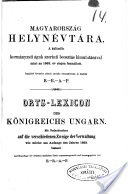
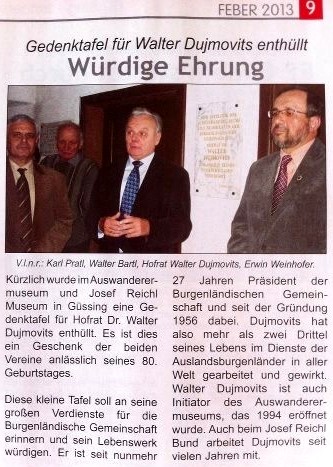 Plaque
for Walter Dujmovits: Below is a translation of an article (passed along by Margaret
Kaiser) recognizing Walter Dujmovits 80th birthday and his contributions to Burgenland
emigrants:
Plaque
for Walter Dujmovits: Below is a translation of an article (passed along by Margaret
Kaiser) recognizing Walter Dujmovits 80th birthday and his contributions to Burgenland
emigrants: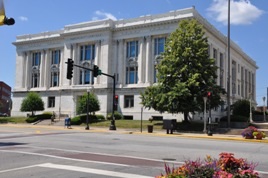 Louis
writes: "FYI, if anyone out there has immigrant ancestors that lived in Madison
County, Illinois, the Madison County Illinois Circuit Clerk has recently finished a new DB
of Immigration & Naturalization Documents, 1850-1959. Complete and indexed scans of
Petitions for Naturalizations, Declaration of Intentions, Oath of Allegiance, etc. 122
Volumes worth! Lots of pre-WWI Hungarians settled in this area. Steel mills, coal
mines...the usual."
Louis
writes: "FYI, if anyone out there has immigrant ancestors that lived in Madison
County, Illinois, the Madison County Illinois Circuit Clerk has recently finished a new DB
of Immigration & Naturalization Documents, 1850-1959. Complete and indexed scans of
Petitions for Naturalizations, Declaration of Intentions, Oath of Allegiance, etc. 122
Volumes worth! Lots of pre-WWI Hungarians settled in this area. Steel mills, coal
mines...the usual."
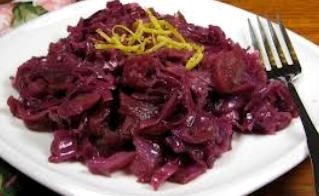 1/2
c. fat
1/2
c. fat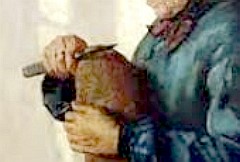 Nancy
Coughlin wrote, saying: Thanks, as ever, for this month's BB Newsletter. I could just see
my mother holding a loaf of bread and cutting it just as the gentleman in the picture. Also,
Grammel Pogatscherl reminded me of having them on a trip to meet my, then, 86-year-old
grandmother in St. Michael, Burgenland, in 1969. It's fun when something in the newsletter
sparks a memory.
Nancy
Coughlin wrote, saying: Thanks, as ever, for this month's BB Newsletter. I could just see
my mother holding a loaf of bread and cutting it just as the gentleman in the picture. Also,
Grammel Pogatscherl reminded me of having them on a trip to meet my, then, 86-year-old
grandmother in St. Michael, Burgenland, in 1969. It's fun when something in the newsletter
sparks a memory.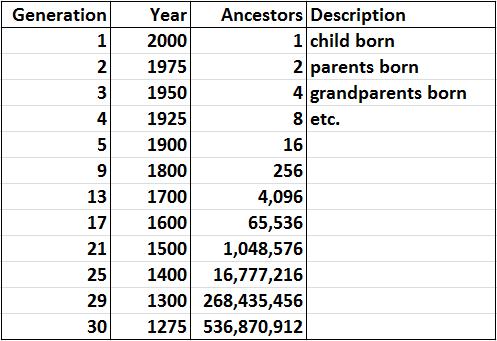 So,
let us assume a child was born in year 2000 and that there is, for convenience of
calculations, exactly 25 years between birth of generations. Now let's work back in time.
So,
let us assume a child was born in year 2000 and that there is, for convenience of
calculations, exactly 25 years between birth of generations. Now let's work back in time. 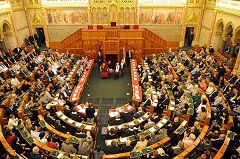 In
1995, the Hungarian Parliament, knowing it wanted to consider drafting a new constitution,
addressed this deficiency by adding Article 23.5, which required a four-fifths vote to
establish a regulatory process for drafting a new constitution. It then voted in such a
process; however, the 2007 Parliament deregulated that process by a four-fifths vote, leaving
itself with no current legal way to draft a new constitution. Nonetheless, Article 23.5 made
it clear that the preparation of a new constitution in the future necessitates the inclusion
of the opposition into the preparatory process, even in case of a two-third majority of the
ruling parties.
In
1995, the Hungarian Parliament, knowing it wanted to consider drafting a new constitution,
addressed this deficiency by adding Article 23.5, which required a four-fifths vote to
establish a regulatory process for drafting a new constitution. It then voted in such a
process; however, the 2007 Parliament deregulated that process by a four-fifths vote, leaving
itself with no current legal way to draft a new constitution. Nonetheless, Article 23.5 made
it clear that the preparation of a new constitution in the future necessitates the inclusion
of the opposition into the preparatory process, even in case of a two-third majority of the
ruling parties. 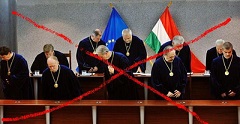 From
the view of what it says, it manipulates the makeup of the Constitutional Court and the
Judiciary, in general, by increasing the number of members on the Constitutional Court,
reducing from 70 to 62 years of age the forced retirement age of judges (on all courts) and of
public prosecutors, and increasing the term of service for most judges by three years. Given
the Fidesz government will appoint the replacement judges and prosecutors, the effect
of these changes is to accelerate the dismissal of judges and prosecutors not beholden to
Fidesz and increase the number supportive of their ideology while also keeping these
individuals in office longer (this was also coupled with an earlier moratorium on filling
vacant judgeships, likely in anticipation of the changes envisioned in the new Constitution).
Further, the replacement of the Supreme Court and the National Council of Justice allows the
government to appoint new presidents and members, ensuring a judiciary almost certainly
supportive of their ideology.
From
the view of what it says, it manipulates the makeup of the Constitutional Court and the
Judiciary, in general, by increasing the number of members on the Constitutional Court,
reducing from 70 to 62 years of age the forced retirement age of judges (on all courts) and of
public prosecutors, and increasing the term of service for most judges by three years. Given
the Fidesz government will appoint the replacement judges and prosecutors, the effect
of these changes is to accelerate the dismissal of judges and prosecutors not beholden to
Fidesz and increase the number supportive of their ideology while also keeping these
individuals in office longer (this was also coupled with an earlier moratorium on filling
vacant judgeships, likely in anticipation of the changes envisioned in the new Constitution).
Further, the replacement of the Supreme Court and the National Council of Justice allows the
government to appoint new presidents and members, ensuring a judiciary almost certainly
supportive of their ideology.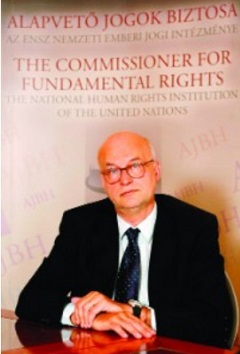 Fundamental
Rights of Citizens: The 2012 Constitution also largely eliminates an element of the
1989 Constitution that provided an independent way for organizations, businesses and citizens
to contest government actions. This element was the system of specialized Ombudsman
for the protection of fundamental rights—individuals who were not part of either the
government or the public administration, were independent of each other, and who could act
with authoritative power in their specialized spheres, making decrees or directly accessing
the judiciary on behalf of citizens. These included ombudsmen for data protection, freedom of
information, future generations, minorities, and general citizens’ rights. The ombudspersons
also served as guarantors for the execution of pertinent directives of the European Union in
their areas of responsibility.
Fundamental
Rights of Citizens: The 2012 Constitution also largely eliminates an element of the
1989 Constitution that provided an independent way for organizations, businesses and citizens
to contest government actions. This element was the system of specialized Ombudsman
for the protection of fundamental rights—individuals who were not part of either the
government or the public administration, were independent of each other, and who could act
with authoritative power in their specialized spheres, making decrees or directly accessing
the judiciary on behalf of citizens. These included ombudsmen for data protection, freedom of
information, future generations, minorities, and general citizens’ rights. The ombudspersons
also served as guarantors for the execution of pertinent directives of the European Union in
their areas of responsibility.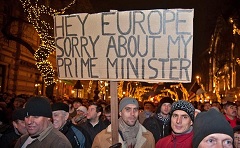 Orban
was gifted his two-thirds majority in 2010 by the spectacular collapse of the outgoing
corrupt and incompetent (but pro-EU and international banking-friendly) Socialist
government. The fact that he has taken advantage of this to concentrate power in the hands
of the ruling party, and to game the system to increase the likelihood of that ruling party
being Fidesz, is a sign of his weakness and insecurity, and not his strength. For my part, I
don’t understand why Orban feels to the need to do this.
Orban
was gifted his two-thirds majority in 2010 by the spectacular collapse of the outgoing
corrupt and incompetent (but pro-EU and international banking-friendly) Socialist
government. The fact that he has taken advantage of this to concentrate power in the hands
of the ruling party, and to game the system to increase the likelihood of that ruling party
being Fidesz, is a sign of his weakness and insecurity, and not his strength. For my part, I
don’t understand why Orban feels to the need to do this.